#CONTEMPORARY ART MUSEUMS IN AMERICA
Explore tagged Tumblr posts
Text
Immerse yourself in the captivating world of museums in the US. Plan your cultural journey today and explore the artistic treasures that define America's heritage.
#ART GALLERIES IN THE US#CONTEMPORARY ART MUSEUMS IN AMERICA#HISTORICAL SITES IN THE UNITED STATES#NATIONAL MUSEUMS IN THE US
0 notes
Text

Beau-Ty. Marcus Brutus. American. 2022.
The Smithsonian National Museum of African American History and Culture.
#marcus brutus#National Museum of African American History and Culture#the Smithsonian#african american history#American history#american art#America#black history#painting#art#culture#history#modern history#contemporary art#contemporary history
10 notes
·
View notes
Text

Niterói Contemporary Art Museum, Niterói, Brazil
Taken by Gustavo Nacht
1 note
·
View note
Video
Stanley Kubrick by Thomas Hawk
#America#Bay Area#CJM#California#Contemporary Jewish Museum#Northern California#SF#SF Bay Area#San Francisco#Stanley Kubrick#The CJM#The Contemporary Jewish Museum#USA#United States#United States of America#West Coast#art museum#museum#norcal#flickr
0 notes
Video
All Work and No Play Makes Jack a Dull Boy by Thomas Hawk
#America#Bay Area#CJM#California#Contemporary Jewish Museum#Northern California#SF#SF Bay Area#San Francisco#Stanley Kubrick#The CJM#The Contemporary Jewish Museum#The Shining#USA#United States#United States of America#West Coast#art museum#museum#norcal#typewriter#flickr
0 notes
Text
Exploring the Heart of Mexican Artistry at Kansas City's Nelson-Atkins MuseumJuly 15, 2013 - From the Archives

View On WordPress
#Art and Politics#Art History#Art in the Americas#artistic expression#Artistic Legacy#Contemporary Mexican Art#Cultural Heritage#Cultural identity#Diego Rivera#Frida Kahlo#Gerardo Suter#Kansas City Art Exhibition#Latin American Artists#mexican art#Mexican Folklore#Mexican Muralism#Nelson-Atkins Museum#Self-Portraiture#Surrealist Art#Visual Narratives
0 notes
Text

Zhang Hongtu | Mai Dang Lao (McDonald's), 2002. Cast Bronze, box of fries: 71/4 × 4 3/4 × 2 1/4 in. (18.4 x 12.1 x 5.7 cm). Brooklyn Museum Collection.
In Mai Dang Lao (McDonald's), a hamburger box, fries container, fork, and knife are cast in bronze and adorned with traditional Chinese motifs like the totie mask, typically featured on ancient ritual bronze vessels used in worship of the ancestors. Here it is combined with the iconic logo of the fast-food giant, transforming the "Happy Meal" into a Shang-dynasty artifact.
The Asian American artist Zhang Hongtu, a leader of the Political Pop movement in contemporary Chinese art, lives in Queens, New York, after emigrating from China in the 1980s. By creatively juxtaposing ancient China with contemporary America, and ritual art with consumer culture, Zhang whimsically critiques systems of power.
159 notes
·
View notes
Text

Dr. Sharbreon Plummer, Diasporic Threads: Black Women, Fibre and Textiles, Edited by Laura Moseley, Designed and illustrated by Saffa Khan, Common Threads Press, [Norwich], 2022 [Idea Books, Amsterdam]

«"Diasporic Threads platforms a stunning selection of works by contemporary Black women textile artists and is rich in critical insight and historical context." - Ferren Gipson, author of Women's Work: From Feminine Arts to Feminist Arts and The Ultimate Art Museum. Diasporic Threads: Black Women, Fibre & Textiles highlights Black women's contributions to art and history through fibre-related mediums. This publication surveys the history of Black women and textiles in North America, and spotlights five artists through a series of interviews, paying careful attention to the intersections of race, art, and cultural memory. The author, Dr. Sharbreon Plummer (Baton Rouge, LA) is an artist, strategist and storyteller that centres the stories and creativity of Black women. Sharbreon's upbringing in southern Louisiana informs her interest into how culture and ancestral memory act as influencers of contemporary art-making. Sharbreon has worked for institutions such as the African American Museum in Philadelphia, Americans for the Arts and the Embroiderers Guild of America.»
#graphic design#art#design#textile#embroidery#quilt#drawing#illustration#book#cover#book cover#sharbreon plummer#laura moseley#saffa khan#common threads press#2020s
18 notes
·
View notes
Text










A curated selection from the Smithsonian American Art Museum, with a few notable additions. Most works span 1750–1950, with exceptions like Raphael's The School of Athens (1509–1511). The collection highlights the evolution of art styles and themes across Europe and America. For example, François-André Vincent's Alcibiades Being Taught by Socrates (1776) captures an intimate moment between teacher and student, rich with Greek cultural significance. This contrasts with Thomas Cole's expansive, transcendental landscapes reflecting post-colonial American ideals. Later works shift to contemporary scenes, such as George Tooker’s The Waiting Room (1959), critiquing the cold bureaucracy of postwar America, a stark contrast to the era’s cultural optimism. Viewing these works offers insight far beyond their surface, revealing the cultural and historical contexts that shaped them.
19 notes
·
View notes
Text
13 notes
·
View notes
Text
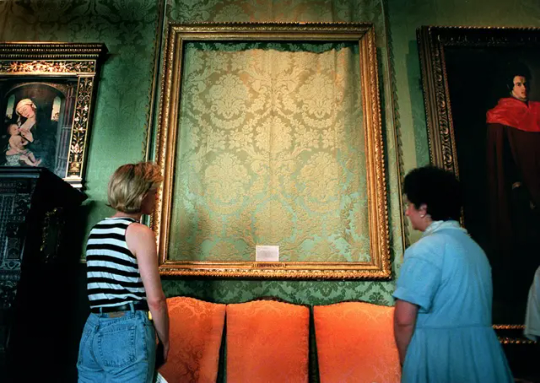
The Isabella Stewart Gardner Museum Theft
Five things you probably didn’t know about the biggest art heist in history
Most art galleries and museums are famous for the art they contain. London’s National Gallery has Van Gogh’s “Sunflowers”; “The Starry Night” meanwhile, is held at The Museum of Modern Art in New York, in good company alongside Salvador Dalì’s melting clocks, Andy Warhol’s soup cans and Frida Kahlo’s self-portrait.
The Isabella Stewart Gardner Museum in Boston, however, is now more famous for the artwork that is not there, or at least, that is no longer there.
On March 18 1990 the museum fell prey to history’s biggest art heist. Thirteen works of art estimated to be worth over half a billion dollars — including three Rembrandts and a Vermeer — were stolen in the middle of the night, while the two security guards sat in the basement bound in duct tape.
The robbery is a treasure trove of surprising facts and unexpected plot twists. Here are five things that make the Isabella Stewart Gardner Museum, and its famous theft, so interesting.
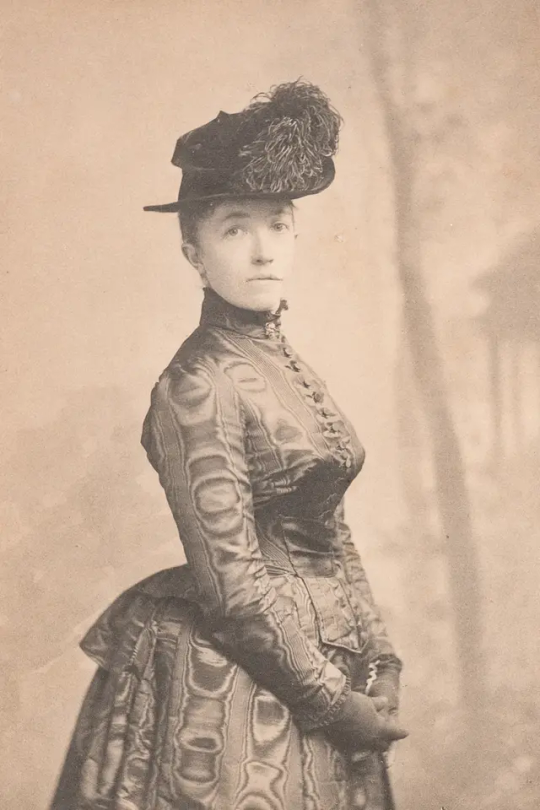
The woman behind the building:
Isabella Stewart Gardner, the museum’s founder and namesake, is a fascinating character. The daughter and eventual widow of two successful businessmen, Gardner was a philanthropist and art collector who built the museum to house her stash.
“When she opened the museum in 1903 she mandated that it be free of charge, to gain the appreciation and the attendance of all of Boston,” Stephan Kurkjian, author of “Master Thieves: The Boston Gangsters Who Pulled Off the World’s Greatest Art Heist”, said in the programme. “Her museum, at that point in time, was the largest collection of art by a private individual in America.”
Gardner also had links to the fledgling campaign for women’s political rights. The museum displays the photographs and letters of her friend Julia Ward Howe, an organizer of two US suffrage societies, and a print of Ethel Smyth, a composer and close friend of the English Suffragette leader Emmeline Pankhurst.
Gardner met Smyth through their mutual friend, the painter John Singer Sargent, whose portrait of Gardener raised eyebrows for the low-cut neckline he gave her.
Gardner seemed to enjoy flirting with scandal and gossip: she once arrived at a Boston Symphony Orchestra performance in a hat band emblazoned with the name of her favorite baseball team, Red Sox, and an illustration in a January 1897 edition of the Boston Globe showed her apparently taking one of Boston Zoo’s lions for a walk.
Somewhat ironically, when the Mona Lisa was stolen in 1911, Gardner told her museum guards that, if they saw anyone trying to rob them, they should shoot to kill.
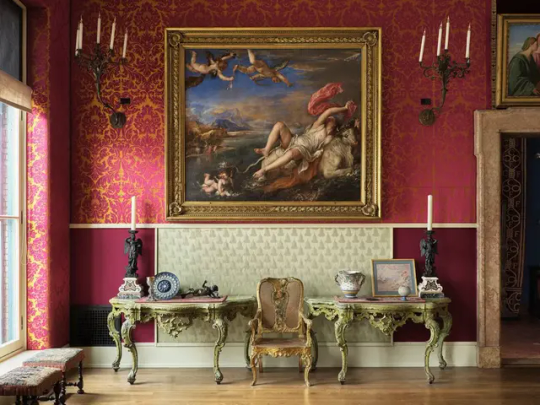
The art not taken:
The thieves’ loot is estimated to be worth over half a billion dollars. However, they left the building’s most expensive artifact: “The Rape of Europa” by Titian, which Gardner bought from a London art gallery in 1896, then a record price for an old master painting.
Why commit history’s greatest art heist and leave without the priciest piece in the museum? Well, size may have played a role. The largest artwork taken was Rembrandt’s “Christ in the Storm on the Sea of Galilee,” famous for being Rembrandt’s only seascape and measures roughly 5x4 feet. “The Rape of Europa,” meanwhile, is larger, at nearly 6x7 feet.

The Napoleon factor:
Around 2005, the investigation into the stolen artworks took a detour to the French island of Corsica in the Meditteranean Sea. Two Frenchmen with alleged ties to the Corsican mob were trying to sell two paintings: a Rembrandt and a Vermeer. Former FBI Special Agent Bob Wittman was involved in a sting to try and buy them — but the operation eventually fell apart when the men were arrested for selling art taken from the Museum of Modern and Contemporary Art in Nice instead.
Why would “Corsican mobsters,” as correspondent Randi Kaye described them in the programme, be interested in robbing a Boston art museum? The answer could lie in the Bronze Eagle Finial, the 10-inch ornament stolen from the top of a Napoleonic flag during the heist.
“It was sort of an odd choice for the thieves to take (the Finial),” Kaye said, “but it turns out that Corsica is essentially the homeland of Napoleon.” The French emperor was born on the island in 1769, and a national museum is now housed in his former family home.
“It is a very compelling notion,” Kelly Horan, Deputy Editor of the Boston Globe, said in the programme, “that a Corsican band of gangsters might have tried to steal back their flag and pull off the entire rest of the heist in the process.”
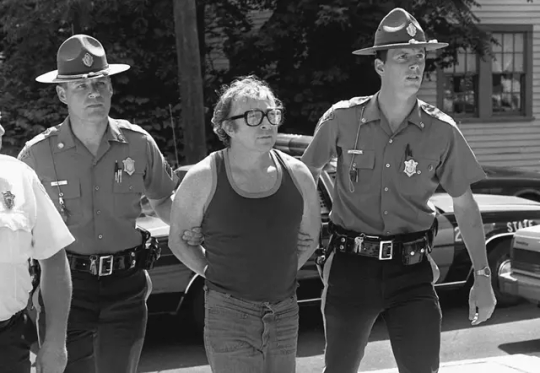
A rock’n’roll suspect:
March 18 1990 was not the first time a Rembrandt had been stolen from a Boston museum. In 1975, career criminal and art thief Myles Connor walked into Boston’s Museum of Fine Arts, and walked out with a Rembrandt tucked into his oversized coat pocket. He was the FBI’s first suspect in the Gardner case, however the walls of federal prison — where he was incarcerated on drugs charges — gave him a pretty solid alibi.
When he wasn’t lifting famous artworks from their displays, Connor was a musician. It was through gigging that he met Al Dotoli, who worked with stars including Frank Sinatra and Liza Minelli.
In 1976 Connor was jailed for a separate art theft committed in Maine. Hoping to use his stolen Rembrandt to leverage a lesser sentence, he needed Dotoli — who was on tour with Dionne Warwick — to turn the painting in to the authorities on his behalf.
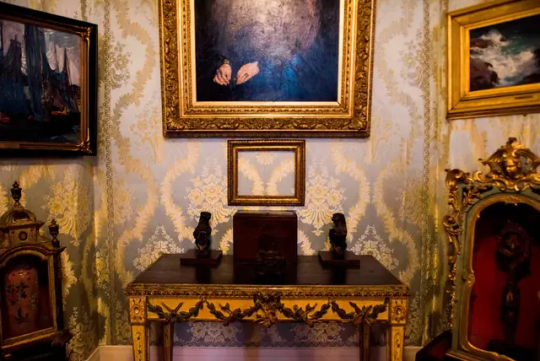
An invisible thief?
One of the stolen artworks, Édouard Manet’s “Chez Tortoni,” was taken from the museum’s Blue Room on the first floor. The painting stands out for two reasons, the first being its frame. The thieves left almost all of the frames behind, cutting some out of the front.
“To even leave remnants of the painting(s) behind was savage,” Horan said. “In my mind, it’s sort of like slashing someone’s throat.”
The “Chez Tortoni” frame was unusual for where it was left, though: not in the room it was stolen from, but in the chair of the security office downstairs. Even more remarkable, not a single motion detector was set off in the Blue Room. Bar investigating the possibility of ghost robbers, investigators wondered if this pointed to the plot being an inside job.
“At the FBI we found that about 89% of museum institutional heists are inside jobs,” Wittman said. “That’s how these things get stolen.”
By Caitlin Chatterton.

#The Isabella Stewart Gardner Museum Theft#The Isabella Stewart Gardner Museum in Boston#Rembrandt#Govert Flinck#Édouard Manet#Johannes Vermeer#Edgar Degas#stolen art#looted art#painter#painting#art#artist#art work#art world#art news#long post#long reads
31 notes
·
View notes
Text
Online History Short-Courses offered by Universities Masterpost
Categories: Classical Studies, Egyptology, Medieval, Renaissance, The Americas, Asia, Other, Linguistics, Archaeology
How to get Coursera courses for free: There are several types of courses on Coursera, some will allow you to study the full course and only charge for the optional-certificate, for others you will need to audit it and you may have limited access (usually just to assignments), and thirdly some courses charge a monthly subscription in this case a 7 day free trial is available.
Classical Studies 🏛️🏺
At the Origins of the Mediterranean Civilization: Archeology of the City from the Levant to the West 3rd-1st millennium BC - Sapienza University of Rome
Greek and Roman Mythology - University of Pennsylvania
Health and Wellbeing in the Ancient World - Open University
Roman Architecture - Yale
Roman Art and Archeology - University of Arizona
Rome: A Virtual Tour of the Ancient City - University of Reading
The Ancient Greeks - Wesleyan University
The Changing Landscape of Ancient Rome. Archeology and History of Palatine Hill - Sapienza University of Rome
Uncovering Roman Britain in Old Museum Collections - University of Reading
Egyptology 𓂀⚱️
Egypt before and after pharaohs - Sapienza University of Rome
Introduction to Ancient Egypt and Its Civilization - University of Pennsylvania
Wonders of Ancient Egypt - University of Pennsylvania
Medieval 🗡️🏰
Age of Cathedrals - Yale
Coexistence in Medieval Spain: Jews, Christians, and Muslims - University of Colorado
Deciphering Secrets: The Illuminated Manuscripts of Medieval Europe - University of Colorado
Enlightening the Dark Ages: Early Medieval Archaeology in Italy - University of Padova
Lancaster Castle and Northern English History: The View from the Stronghold - Lancaster University
Magic in the Middle Ages - University of Barcelona
Old Norse Mythology in the Sources - University of Colorado Bolder
Preserving Norwegian Stave Churches - Norwegian University of Science and Technology
The Book of Kells: Exploring an Irish Medieval Masterpiece - Trinity College Dublin
The Cosmopolitan Medival Arabic World - University of Leiden
Renaissance ⚜️🃏
Black Tudors: The Untold Story
European Empires: An Introduction, 1400–1522 - University of Newcastle
The Mediterranean, a Space of Exchange (from Renaissance to Enlightenment) - University of Barcelona
The Life and Afterlife of Mary Queen of Scots - University of Glasgow
The Tudors - University of Roehampton London
The Americas 🪶🦙🛖
History of Slavery in the British Caribbean - University of Glasgow
Indigeneity as a Global Concept - University of Newcastle
Indigenous Canada - University of Alberta
Indigenous Religions & Ecology - Yale
Asia 🏯🛕
Contemporary India - University of Melbourne
Introduction to Korean Philosophy - Sung Kyun Kwan University
Japanese Culture Through Rare Books - University of Keio
Sino-Japanese Interactions Through Rare Books - University of Keio
The History and Culture of Chinese Silk - University for the Creative Arts
Travelling Books: History in Europe and Japan - University of Keio
Other
A Global History of Sex and Gender: Bodies and Power in the Modern World - University of Glasgow
A History of Royal Fashion - University of Glasgow
Anarchy in the UK: A History of Punk from 1976-78 - University of Reading
Biodiversity, Guardianship, and the Natural History of New Zealand: A Museum Perspective - Te Papa
Empire: the Controversies of British Imperialism - University of Exeter
Great South Land: Introducing Australian History - University of Newcastle
Indigeneity as a Global Concept - University of Newcastle
New Zealand History, Culture and Conflict: A Museum Perspective - Te Papa
Organising an Empire: The Assyrian Way - LMU Munich
Plagues, Witches, and War: The Worlds of Historical Fiction - University of Virginia
Russian History: from Lenin to Putin - University of California Santa Cruz
Linguistics 🗣️
Introduction to Comparative Indo-European Linguistics - University of Leiden - Coursera version
Miracles of Human Language: An Introduction to Linguistics - University of Leiden
Archeology 💀
Archeoastronomy - University of Milan
Archaeology and the Battle of Dunbar 1650 - Durham University
Archaeology: from Dig to Lab and Beyond - University of Reading
Archeology: Recovering the Humankind's Past and Saving the Universal Heritage - Sapienza University of Rome
Change of Era: The Origins of Christian Culture through the Lens of Archaeology - University of Padova
Endangered Archaeology: Using Remote Sensing to Protect Cultural Heritage - Universities of Durham, Leicester & Oxford
Enlightening the Dark Ages: Early Medieval Archaeology in Italy - University of Padova
Exploring Stone Age Archaeology: The Mysteries of Star Carr - University of York
Forensic Archaeology and Anthropology - Durham University
Roman Art and Archeology - University of Arizona
The Changing Landscape of Ancient Rome. Archeology and History of Palatine Hill - Sapienza University of Rome
#side note: most of the universities that offer courses in English on these sites are European or American(USA)#so the lack of courses about Asia (other than Japan) The Americas and Africa is not because of me#history#historical#classical studies#ancient Greece#ancient Rome#pompeii#Egyptology#pharaoh#ancient Egypt#medieval#medieval europe#Medieval Arabia#Renaissance#Tudor#the tudors#history courses#courses#linguistics#archeology#archeology courses#resources#free resources
179 notes
·
View notes
Text
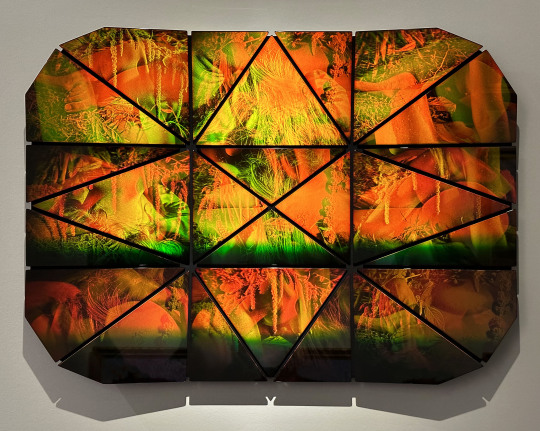
Sarah Meyohas, “Interference #19”, 2023, Holograms, mirrored black glass, aluminum
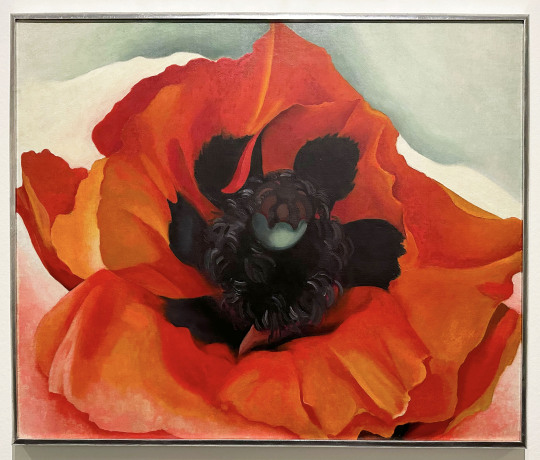
Georgia O’Keeffe, “Poppy”, 1927, Oil on canvas


Francis Picabia “The Church of Montigny, Effect of Sunlight” 1908, Oil on canvas (left); Christian Sampson “Projection Painting”, 2023, Acrylic and films with LED light; and Claude Monet “The Houses of Parliament, Effect of Fog, London” 1904, Oil on canvas (right)
The Nature of Art exhibition at the Museum of Fine Arts St. Petersburg merges art from the museum’s collection with loaned works to explore- “art’s crucial role in our evolving quest to understand our relationship with nature and our place in the cosmos”.
One of the benefits of an encyclopedic museum is that visitors have the opportunity to experience art throughout history, and to revisit works that resonate with them. For the section titled Artist as Curator, Sarah Meyohas and Christian Sampson chose pieces from the museum’s collection to pair with their own work.
From the museum-
At first glance, perhaps, these may seem like unusual combinations, but upon deeper contemplation, their selections reveal complementary artistic intents. For instance, Meyohas and Georgia O’Keeffe share an interest in close looking, particularly in finding new ways to examine underappreciated aspects of the natural world. Sampson, influenced by the California Light and Space Movement, is interested in current scholarship that suggests the hazy fog found in Claude Monet’s work is an early depiction of air pollution, offering an entirely new perspective on the artist’s representations of light.
Sampson also created the four-part installation, Tempus volat, hora fugit, on view until 2025 at the museum.
Below are some of the works from additional sections of the exhibition.


Postcommodity, “kinaypikowiyâs”, 2021, Four 30.5-metre industrial debris booms
Postcommodity is an interdisciplinary art collective comprised of Cristóbal Martínez (Genizaro, Manito, Xicano), and Kade L. Twist (Cherokee).
About Postcommodity’s work, kinaypikowiyâs, (seen above) from the museum-
This work is composed of debris booms, used to catch and hold environmental contaminants such as garbage, oil, and chemicals. The colors of the booms correspond to different types of threats— red (flammable), yellow (radioactive), blue (dangerous), and white (poisonous)-in the labeling system for hazardous materials. To indigenous peoples, these are shared medicine colors that carry knowledge, purpose and meaning throughout the Western Hemisphere. Suspended like hung meat, the booms represent a snake that has been chopped into four parts. Each part represents an area of the colonial map of the Western Hemisphere: South America, Central America, North America, and all of the surrounding islands. The title, kinaypikowiyâs, is a Plains Cree word, meaning snake meat. Divided by borders, Postcommodity asserts that all people living in the Americas are riding on the back of this snake.


James Casebere, “Landscape with Houses (Dutchess County, NY), 2009, Archival pigment print mounted to Dibond
James Casebere creates architecturally based models for the large scale photographs seen above.
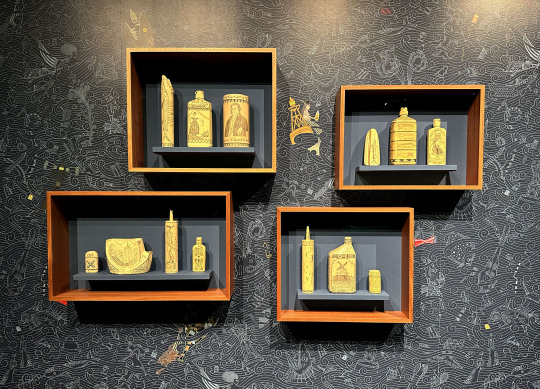


Duke Riley's Reclaimed ocean plastic sculptures and “Tidal Fool” wallpaper
Duke Riley’s work, which was previously shown at Brooklyn Museum, addresses issues of environmental pollution by using discarded plastics found in the ocean and other waterways to create new work inspired by the past. You can hear him discuss his work in this video.
From the museum-
Inspired by the maritime museum displays he saw while a child growing up in New England, Riley’s scrimshaw series is a cutting observation of capitalist economies-historic and today-that endanger sea life. The sculptures were created for the fictional Poly S. Tyrene Memorial Maritime Museum, and are contemporary versions of sailors’ scrimshaw, or delicately ink-etched whale teeth and bone. Riley first thought about using plastic as an ode to scrimshaw when he saw what he thought was a whale bone washed up on the beach in Rhode Island; it turned out to be the white handle of a deck brush. Riley regularly removes trash from beaches and waterways, and often uses this refuse in his work.
Riley collaborated with Brooklyn-based Flavor Paper to create these two custom wallpapers for his solo exhibition DEATH TO THE LIVING, Long Live Trash at the Brooklyn Museum. Tidal Fool exhibits Riley’s trademark humor in the face of devastating water pollution; notice the Colt 45-guzzling mermaid. Wall Bait vibrantly references Riley’s meticulous fishing lures, which he crafts from refuse found in the waters around New York City.


Daniel Lind-Ramos,"Centinelas de la luna nueva (Sentinels of the New Moon)", 2022-2023, Mixed media
From the museum about this work-
In Centinelas de la luna nueva, he evokes the elders of the mangroves, spiritual beings who watch over and ensure the health of this essential coastal tree. Mangroves are the basis for a complex ecosystem that shelters sea life and serves as the first line of defense in the tropical storms that batter the sub-tropics -including Florida.
Lind-Ramos's practice reflects the vibrant culture of his native Loíza, Puerto Rico, by honoring local agriculture, fishing, cooking, and masquerade. His sculptures also evoke Hurricane Maria (2017), the COVID-19 pandemic, and ongoing environmental degradation. Lind-Ramos is committed to the survival and sustenance of Afro-Taíno traditions and people of the Puerto Rican archipelago. However, his art engages the global community through shared emotions, parallel histories, and the commonality of human experience.
The next post will discuss two other artists in the exhibition, Brookhart Jonquil and Janaina Tschäpe.
#Art#Museum of Fine Arts St. Petersburg#The Nature of Art#St. Pete Art Shows#Art Shows#Sarah Meyohas#James Casebere#Christian Sampson#Kade L. Twist#Christóbal Martínez#Postcommodity#Claude Monet#Daniel Lind-Ramos#Duke Riley#Georgia O'Keeffe#Environmental Art#Flavor Paper#Florida Art Show#Florida Art Shows#Francis Picabia#Holograms#Brooklyn Museum#Light and Space#Mixed Media Art#Models#Painting#Photography#Plastic#Recycled Art#Janaina Tschäpe
34 notes
·
View notes
Note
top five books !!
Hi there!
Thank you so much for your ask x
This was so hard to narrow down. But here we go, haha. This also ended up a bit longer than I intended. Whoops!
My Top 5 Books:
Giovanni's Room by James Baldwin. My God. Where do I begin with this painfully beautiful exploration of sexuality, identity, yearning, forbidden desire, repression, and grief all done in 159 pages?
Baldwin is a genius, my favorite writer of all time, and a true inspiration to me. He captured the dredges of the human psyche in this novel (in all of his novels, really) with such brutal honesty that smoothly oscillates between clean cut, surgical clarity and an achingly elegant beat of poetic prose. I first read the book at 17. I have reread it countless times since.
As a writer, I am so deeply touched by and indebted to Giovanni’s Room, the literary prowess of James Baldwin, and the impact his writing has had on me throughout my life.
Such a Fun Age by Kiley Reid. A relevant story on the perils of performative wokeness and classism as it feeds into casual racism/microaggressions, toxic relationships, and misogynoir. The protagonist is a young black nanny named Emira who is wrongfully accused of kidnapping the white child she’s babysitting by a security guard at a grocery store.
This book is the embodiment of the saying: “the most disrespected person in America is the black woman.” Emira is tried and tested at every turn, stuck in a cycle of devaluation and outright dismissal of her time, her energy, and her intelligence. Despite all the chaos, she’s not to be played with, and she circumvents the harmful stereotype of the “strong black woman.” Instead of having to strictly endure the pain and negativity thrown at her with complete stoicism, she allows herself the space to be vulnerable, to explore her self-doubts, and to process the impact the grocery incident had on her.
Black women can be soft, too, blue, too, and that's absolutely okay. This is so important to see represented in media, in literature, and in life.
Ways of Seeing by John Berger. There are a number of texts that dismantle elitism, the male gaze, and highlight the importance of historical, social, and cultural context to truly understand art, but Berger does it in a way that is accessible and timeless.
His work has always been a staple in my own research and institutional critiques on the inaccessibility of the art world, the austerity of museum spaces and practice, and the continued exclusion and mishandling of marginalized narratives within our canonical understanding of modern and contemporary art.
(Pssst…Outside of Berger, let me turn you on to performance artist Andrea Fraser, whose institutional critiques are hilarious, unapologetic, and without fail a gloriously biting commentary on the absurdity of the art world and our obsession with its lusty commodification and pretentiousness. Little Frank and His Carp (2011) is still a performance that lives rent free in my head.)
The Great Gatsby by F. Scott Fitzgerald. This book holds sentimental value for me. It was one of my dad’s favorites, and he loved the 1974 film adaptation.
What’s not to love about this American classic that captures nostalgia in such a poignant way? We also have the glitz and glamour of the Roaring 20s, the socialites, fake identities/personalities, obsession, unrequited love, broken dreams and promises, and murder.
And it’s all depicted in such a lush and beautiful way that it takes you almost by surprise when you finally realize just how terrifyingly cold and empty this world that Fitzgerald crafted for us is. Love it!
The Trial by Franz Kafka. No one portrays absurdism, existentialism, loneliness, and depressed but horny unreliable narrators quite like Kafka! He is a master at building dread and confusion while disorienting his imperfect protagonists (and his readers) by dropping us in the middle of harrowing situations.
I’m a huge fan of his work, and it’s hard to narrow down my appreciation of it to just one book for this list, but The Trial has to be my absolute favorite. I am a sucker for witnessing the moral flailing of somewhat problematic protagonists. K’s arrogance and superiority, tempered by his utter helplessness and increasing instability against the metaphysical force of the Law, make him an instant favorite character of mine. He struggles against a tyrannical bureaucratic system hellbent on stripping away his autonomy by trapping in the ambiguity of an inexplicable hell. K never learns of the crime he's being accused of and neither do we as the reader.
The book satisfies my love for a critique of flawed judicial systems, while also exploring the impact of paranoia, isolation, and existential dread, all wrapped up in the tension of a psychological horror/thriller. I also love a story that comes full circle at the end, even if it is abrupt, tragic, and maybe even meaningless, despite K.'s desperation to find meaning within the absurd.
Ask me my "TOP 5/TOP 10" anything!
#personal#Trish speaks#answered asks#literature#art#Museums#art theory#performance art#life changing books#timeless literature#Black Lives Matter#Queer Representation#James Baldwin#Franz Kafka#John Berger#Kiley Reid#f. scott fitzgerald#absurdism#existentialism#philosophy#asks me things!
7 notes
·
View notes
Text

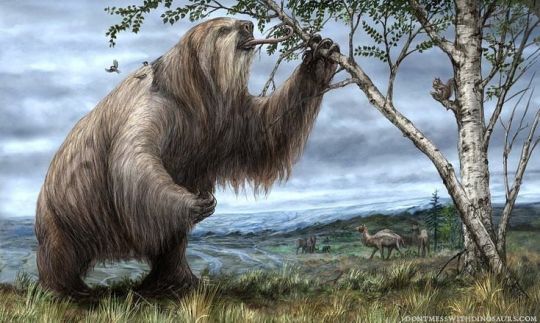






Megatherium known as the giant ground sloth or the megathere is an extinct genus of ground sloth which lived throughout South America from the Pliocene to Pleistocene some 5 million to 12,000 years ago. The first known remains of Megatherium consisting of a mostly complete skeleton were discovered in 1788 by Manuel Torres, on the bank of the Luján River in Argentina. The fossil was shipped to Museo Nacional de Ciencias Naturales in Madrid the following year, where it remains. It was reassembled by museum employee Juan Bautista Bru in 1795 and subsequently described by Georges Cuvier in 1796. Cuvier assigned the fossil the scientific name Megatherium americanum from the Greek méga 'great' and theríon 'beast' and americanum being a reference to the Americas. In the centuries to follow dozens of well preserved specimens have been recovered representing some 8 species considered valid: M. americanum, M. altiplanicum, M. gallardoi, M. istilarti, M. medinae, M. parodii, and M. sundti which are separated into the two sub-genuses of Megatherium and Pseudomegatherium. With the largest species reaching some 20ft (6m) in length, 7ft (2.1m) tall when on all fours, and 8,400 to 10,100lbs (3,810 to 4580kgs) in weight, megatherium surpassed most modern elephants in size making it not only one of the largest xenathrans but one of the largest mammals known to have ever existed. Megatherium had a robust skeleton with a large pelvic girdle and a broad muscular tail. Its large size enabled it to feed at heights unreachable by other contemporary herbivores. Rising on its powerful hind legs and using its tail to form a tripod, Megatherium could support its massive body weight while using the curved claws on its long forelegs to pull down branches. These large animals likely lived in small groups feeding during the day before spending there nights resting inside of caves and large burrows the animals likely dug using there massive claws. Megatherium became extinct around 12,000 years ago during the Quaternary extinction event, which also claimed most other large mammals throughout the world. The extinction coincides with the settlement of the Americas, and multiple kill sites where M. americanum was slaughtered and butchered, suggesting that human hunting helped caused the sloths extinction.
Art belongs to the following creators:
Megatherium Mother and Baby: Mark Witton https://www.redbubble.com/i/art-board-print/Megatherium-by-MarkWitton/40411556.TR477
Megatherium: Brian Engh
Lost World - Megatherium: Rob Brunette https://www.artstation.com/artwork/3dbQXY
#pleistocene pride#pleistocene#pliestocene pride#pliestocene#cenozoic#ice age#stone age#giant sloth#sloth#ground sloth#giant ground sloth#megatherium#pliocene#south america#megafauna#prehistoric#prehistoric animals
15 notes
·
View notes
Video
Trip to Space by Thomas Hawk
#2001: A Space Odyssey#America#Bay Area#CJM#California#Contemporary Jewish Museum#Northern California#SF#SF Bay Area#San Francisco#Stanley Kubrick#The CJM#The Contemporary Jewish Museum#USA#United States#United States of America#West Coast#art museum#bw#museum#norcal#flickr
0 notes


